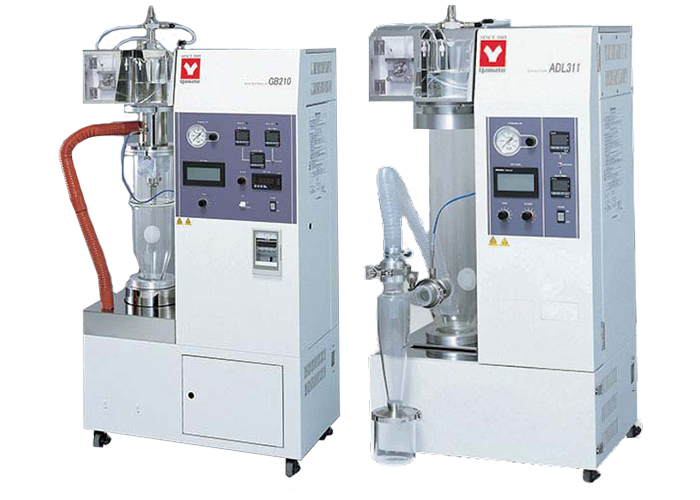Spray drying continues to be the preferred drying method for several heat-sensitive materials in food, medicinal, and industrial applications because of its low-cost and efficient properties of converting liquid to fine dried powder. This method employs an atomizer and heating gas to transform liquid into dry powders, granules, or agglomerates. Some products that are dried using this process include milk, beverages, vitamins, colorings, detergent, and other powders.

The spray drying process starts by pre-concentrating the liquid to be dried, increasing its solid content and reducing the amount of liquid that has to be evaporated in the spray dryer. The solution or suspension is fed into the drying chamber through a nozzle where the drying gas has been continuously flowing. The feed undergoes a process called “atomization” where optimal conditions for evaporation are created using a nozzle or rotary atomizer which converts the solution into fine droplets within the chamber.
Evaporation then starts once the droplet makes contact with the heated gas, leaving the dried solids at the bottom of the chamber. The drying gas carries the dried solids out of the chamber and the cyclone separates the particles from the drying gas. The powder is collected in the product vessel directly attached to the bottom of the cyclone.
Download the Sample Determination for Spray Drying Guide here
APPLICATIONS OF SPRAY DRYING
Spray drying can be used in a wide range of applications such as pharmaceuticals, food & beverage, agriculture, chemicals, polymer, ceramic, cosmetics & fragrances, and materials research. Its application is widespread across many industries. It can also be used for heat sensitive and heat resistant substances. Furthermore, spray drying increases product shelf life and reduces product weight making it easy to transport.
The type of spray dryer determines particle size, bulk density, crystallinity degree, organic volatile impurities and residual solvents. The quality of the powder remains constant during the entire spray drying process. However, changing the parameters like nozzle size, inlet temperature and flow rate and sprayed pressure may alter the final product.
THINKING ABOUT YOUR FINISHED PRODUCT
Apart from scale, components, and the overall spray drying system type, users must also think about the final product that they want to achieve at the end of the spray drying process.
Consider the powder specifications you need to have at the end of the process such as dissolution, moisture percentage, flowability, microbiological standards, and particle size. For example, even factors such as powder color can be controlled through the use of colloidal or micellular dispersions or multilayer emulsions prior to spray drying.
A FEED FORMULA’S ROLE
Your feed formula and specifications will also play a role in the selection process as more often than not, materials to be spray dried will require a formula. Apart from the active ingredient and water, your feed formula may also include a carrier, a flow agent, an emulsifier, and an antioxidant. For actives, ask yourself the following:
- Does it have a low flash point?
- Is it hygroscopic?
- Is it water or oil soluble?
- What is its purity?
- Does this material have a standard % load range?
QUESTIONS TO ASK
Here are some additional guide questions that you might want to ask yourself to give you a clearer idea as to the spray dryer unit you will need:
- What is your target particle size?
- What temperature profile will you need?
- How much moisture should your finished product have?
- Is the liquid feed material a solution or dispersion?
- Is the finished powder hydrophilic, flowable, or tacky?
- What is the viscosity of the liquid slurry?
- Are there any limitations or requirements for storage and handling the raw material or final product?
- What is the percentage of solids going into the spray dryer?
TYPES OF SPRAY DRYERS
Yamato offers 3 different models of laboratory spray dryers. These products can be used for experimental purposes to determine spray drying parameters such as drying temperature, sample feed rate, air flow rate, droplet size, and solvent content of dried powder.

- ADL311SA is an economical laboratory spray dryer featuring excellent performance, simple operation and easy set up and clean up.
- GB210 is the versatile spray dryer and granulation 2 in 1 system. GB210A is the spray dryer and GB210B is the granulation unit. Easy to switch by changing the glassware.
- DL410 is the large capacity laboratory spray dryer with higher processing capability, suitable for R&D and semi-production purpose. This unit can obtain bigger particle size.
COMPLETE A SURVEY SHEET
Determining if your samples will work with the existing Yamato spray dryer models is an easy process. The initial recommended step would be to complete the Yamato Spray Dryer Preliminary Survey Sheet and email it to us. Information provided will determine if any of Yamato’s existing spray dryer configurations are suitable for your requirements. Yamato can then offer a sample test at Santa Clara, California or Minami Alps Factory in Japan.EXPERTS IN SPRAY DRYING
With over 125 years of experience in the industry, Yamato Scientific America is equipped with providing utmost quality service and high performing products in the scientific market. All products are manufactured in compliance with stringent quality standards and international regulatory requirements.
Whether you are ready to make a purchase or still need to do more research, Yamato Scientific America is here to help. Contact us at 1-800-292-6286 or reach us at customerservice@ yamato-usa.com.
Download the Sample Determination for Spray Drying Guide here